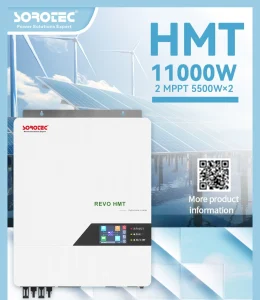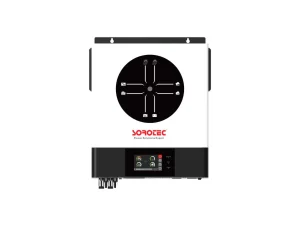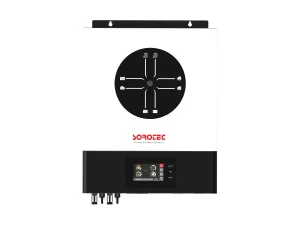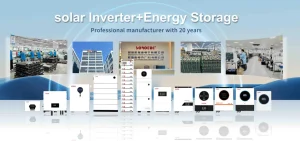Parallel inverters and series inverters differ significantly in their applications and operational characteristics. Both types of inverters offer unique advantages depending on the specific requirements of the application, with parallel inverters focusing on reliability and scalability, and series inverters achieving higher voltage outputs.
Core Principles of Parallel and Series Inverters
Fundamental Working Mechanisms of Parallel Inverters
Parallel inverters are meant for running multiple inverters together and balancing the load between every connected unit. It allows for multiple inverters to work in tandem by synchronizing the outputs of each inverter.
The biggest benefit of this mechanism is that it is simple to scale up and redundant. This means that if one component breaks, the other components can continue to function, so downtime is minimized and reliability is guaranteed.
This makes these systems well-suited for applications that require a high power output. Such parallel configurations can share the load among several inverters thus giving parallel configurations the capability to manage significant loads that a solitary inverter may have difficulty bearing.
Operational Mechanisms of Series Inverters
Series inverters, on the other hand, operate by connecting several units in series, effectively boosting overall output voltage rather than output current. This pattern is used for those applications with an elevated voltage amount but not a sum of money on current value. In this configuration, the output of each inverter adds up to the voltage, which is ideal for long-distance power transmission or applications needing a higher voltage input.
This intrinsic nature of series configurations also requires fewer components as compared to a parallel setup. Of course, that also means that if one unit goes down, the system could be affected because they are all connected.
Application Scenarios for Parallel Inverters
Optimal Use Cases in Industrial Environments
Industrial parallel inverters lead the way in areas with high volume, offering powerful and dependable power solution systems. An example of this would be throughout manufacturing plants, which rely on power supply for machinery and equipment to work seamlessly. In a parallel system, redundancy is provided to ensure that the operations continue unaffected even if one of the inverters experiences problems.
Moreover, these arrangements are mainly flexible to different loads. This flexibility considerably benefits industries where energy use varies, as more inverters can be added effortlessly to meet growing loads.
Advantages in High-Capacity Systems
In systems with high capacity, like data centers or renewable energy installations, parallel inverters are heavily used because of their scalability and fault tolerance. Consistent power is imperative in data centers so that servers do not go down and data is lost. Parallel configurations bring such reliability by distributing the load across multiple units.
Parallel setups can also be seen in renewable energy systems such as solar farms, where energy storage and distribution are managed. This modular capability allows them to scale with energy needs while ensuring they maintain peak performance.
Application Scenarios for Series Inverters
Effective Deployment in Low-Power Systems
Series inverters are used in low-power applications where there is a need for higher voltage without a corresponding increase in current. They are often employed in home solar systems or smaller renewable devices where size and efficiency are significant considerations. Typically used for residential or small-scale solar installations or renewable energy projects where compactness and efficiency are prioritized.
It’s simpler to do series configurations, so those setups are cheaper for such use cases. They are a scalable solution for low power, and they require fewer components than parallel setups, making implementation slick but efficient. They require fewer components, making them less complex than similar parallel setups, and thus provide a simple yet effective solution for low-power applications.
Benefits in Voltage Boosting Applications
Another place where series inverters excel is voltage boosting. These systems link multiple units in sequence to deliver the high voltages needed for some industrial work or, in the case of power transmission to long distances. These systems can be designed by stacking many units in series, thereby obtaining high voltages needed for some industrial processes and power transmission, especially long-distance transmission.
This ability can be illustrated by the example of hybrid on & off-grid energy storage inverters from SOROTEC with broader PV input ranges (60~450VDC). The mastery of the warmness of AC (and PV) output use time can be configured as the priority of result use, making them exquisite appliances in all situations of the need for voltage control. SOROTEC is a high-tech enterprise specializing in power electronics product development and production.
Key Differences Between Parallel and Series Configurations
Variations in Load-Sharing Capabilities
In this way, parallel configurations shine as they load share between multiple inverters. This approach enables high-power demands to be handled, with load sharing across all connected units. However, if any of the inverters fails—the other inverters will still work so there will always be power if one of the inverters fails.
On the other hand series configurations are not concerned with load sharing but with increasing the voltage. In a series connection, inverters are connected one after the other, and in this case, the voltage level increases and the current remains constant.
The responsiveness of parallel systems, by adding or removing units, to varying energy needs provides them unparalleled scalability. For applications needing a high output voltage but relatively small current output, series systems are more compact and efficient.
Efficiency Differences in Diverse Applications
Application-specific approach coupled with the operational demands determines the inverter configurations and efficiencies for its usage. In the case of systems with varying energy requirements, parallel systems tend to be very efficient since they can scale their size easily without losing much efficiency.
As an example, installations of renewable energy like solar farms make use of the parallel inverter setups allowed by this implementation, increasing the number of units and adding them to the same connection as energy needs increase.
However, series configurations are more efficient in applications. Due to their simple design, fewer components are required, making them cheaper and easier to maintain.
Selecting the Right Inverter Configuration for Specific Needs from SOROTEC
Factors to Consider for Application Suitability
Choosing between parallel inverter and series inverter configurations depends on several factors:
Power Requirements: Determine whether your application requires higher current capacity or elevated voltage levels.
Scalability: Parallel inverter systems are better suited for applications with growing energy demands due to their modular nature.
Reliability: For critical operations where downtime is not an option, parallel setups offer greater fault tolerance.
Cost-Effectiveness: Series configurations may be more economical for low-power applications due to their simpler design.
Application Type: Industrial environments and renewable energy systems often benefit from parallel setups, while residential solar projects may find series configurations more suitable.
REVO VM II PRO Hybrid Solar Energy Storage Inverter is suitable for both on-grid and off-grid applications. The very usage of cutting-edge technology being able to serve multiple needs efficiently is well demonstrated in the use of features such as built-in MPPT chargers with battery equalization functions that help in stretching battery cycles.
For those seeking reliable solutions tailored to specific requirements, SOROTEC provides cutting-edge products designed for maximum performance and cost-effectiveness. Their products meet international safety standards.
FAQs
Q1: What are the primary differences between parallel inverter and series inverter configurations?
A: Parallel setups focus on increasing current capacity through load sharing across multiple units, while series setups aim at boosting voltage by connecting units sequentially.
Q2: Which configuration should I choose for a solar farm?
A: Parallel configurations are ideal due to their scalability and ability to manage high-capacity energy storage efficiently.
Q3: How do hybrid energy storage inverters enhance reliability?
A: Hybrid models integrate advanced features like MPPT chargers and battery equalization functions, ensuring optimal energy storage performance while supporting both on-grid and off-grid applications.










